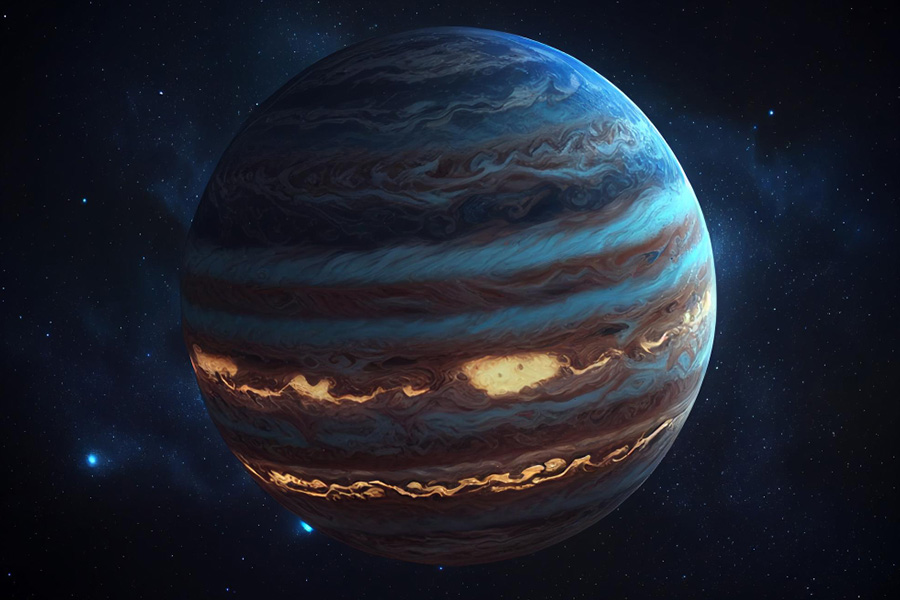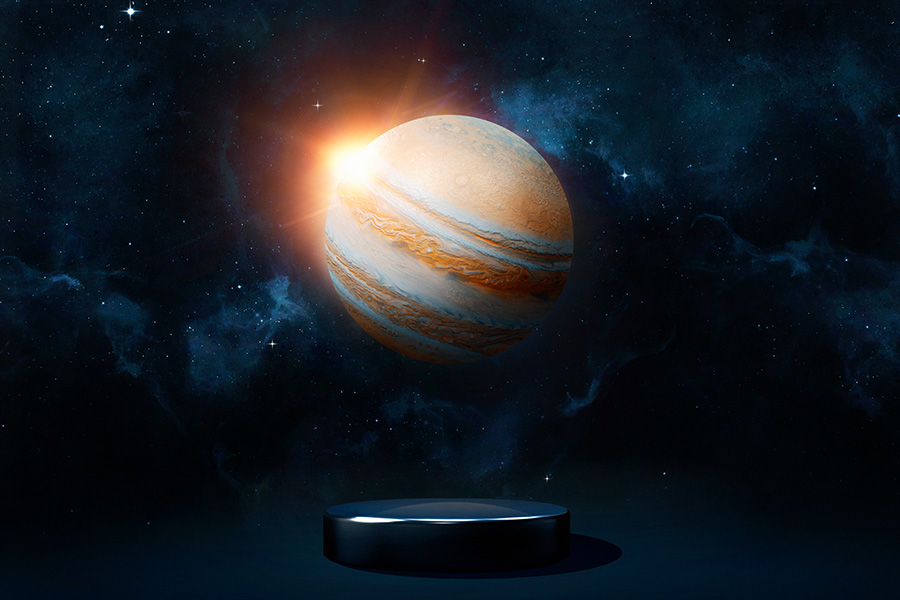Jupiter, the largest planet in our solar system, has long fascinated astronomers and space enthusiasts alike. With its iconic Great Red Spot and colorful cloud bands, this gas giant is full of mysteries and has perplexed astronomers for centuries in regard to its temperature. So, what about the temperature on Jupiter? Is Jupiter cold or hot?
As with many scientific questions, the answer is not straightforward. Both freezing and scorching extremes exist on this enigmatic planet. Both freezing and scorching extremes exist on this enigmatic planet.
In this article, we will explore the factors that lead to this dichotomy of temperatures and what it can reveal about the mysteries that still surround Jupiter. Join us as we navigate the intricate world of Jupiter’s temperatures and the secrets they hold.
Is Jupiter Cold or Hot?
Jupiter features both hot and cold regions. Being five times further from the Sun than the Earth, the upper layers of the atmosphere receive very little energy, meaning that the upper layers of Jupiter are very cold.
However, as we go into the inside layers of Jupiter, we notice that the temperature gradually increases. As a matter of fact, the interior of Jupiter is very hot, and no one can say for sure just how hot the inside of Jupiter is.
It’s hot deep inside due to gravitational compression, while its upper atmosphere is much colder. The internal heat generates storms and turbulent atmospheric conditions, making Jupiter both hot and cold, depending on the location.
We can conclude that the outer region is very cold, but as you go towards Jupiter’s core, the temperature drops significantly.

The Cold Side of Jupiter
Jupiter’s distance from the Sun
Jupiter’s distance from the Sun averages about 740 million kilometers – that’s around five times farther than Earth’s distance! This massive distance means Jupiter receives much less solar heating than planets like Earth and Mars, which are closer to the Sun.
Let’s think about Jupiter’s temperature using an analogy. Imagine the Sun is a campfire, and the planets are marshmallows roasting around it. Earth would be like a marshmallow, nice and close to the flames, getting hot and toasty.
Jupiter would be the marshmallow on the outer edge of the campfire that barely gets warmed because it’s so far from the center. The marshmallows closer to the fire (closer planets) feel more heat, while the marshmallows farther away get way less.
This is because of something called the inverse square law – the intensity of radiation drops exponentially with distance. So Jupiter’s over 740 million km distance from the Sun leaves it out in the planetary cold! The tiny bit of solar heat it gets is only 3% of what Earth receives.
No wonder Jupiter’s outer layers are so frigidly cold! Being five times farther than Earth is like being five times farther from the cozy campfire.
The upper atmosphere and cloud layers
In Jupiter’s uppermost cloud layers, temperatures can plummet to a bone-chilling -145°C. To put this into perspective, that’s even colder than the frigid regions of Earth’s polar zones. Within these high-altitude layers, ammonia clouds dominate the scene, with their cloud-top temperatures reaching a teeth-chattering -170°C.
Adding to the frosty charm of Jupiter is the intriguing tropopause region, a boundary where the atmosphere transitions from cooling to warming as you move deeper into the planet.
On Jupiter, this atmospheric boundary exhibits temperatures hovering around -110°C, making it significantly colder than the tropopause on Earth. These extreme temperature variations within Jupiter’s upper atmosphere showcase the remarkable complexity of the gas giant’s climate.
The Hot Side of Jupiter
Internal heat sources
Jupiter gives off almost twice as much energy as it receives from the distant Sun. This implies that the bulk of Jupiter’s heat comes from within the planet itself. One internal heat source is gravitational compression.
Jupiter’s enormous mass generates tremendous pressure, squeezing and compressing the interior. This compression produces heat, like how repeatedly squishing a rubber ball makes it warmer. Jupiter’s powerful gravity compacts the material inside, heating up the core in the process.
The core is estimated to reach staggering temperatures of 20,000-30,000°C – as hot as the surface of the Sun! At these extreme temperatures under millions of times Earth’s atmospheric pressure, hydrogen – the main component of Jupiter’s composition – is compressed into a highly conductive liquid metallic form.
This electrically charged fluid hydrogen generates strong convection currents and spinning magnetic fields within the core.
The intense churning motions act like an internal engine, while the interactions between charged particles and magnetic fields produce even more internal heat. It’s like an enormous dynamo down there! The blistering core temperature also causes heat to radiate outward, helping warm the overlying layers.
Atmospheric warming
While the uppermost layers are frigid, deeper down, Jupiter’s atmosphere starts to warm thanks to heat from the planet’s interior. In the dense lower atmosphere, warm air parcels can rise rapidly, transporting heat from deeper, hotter layers closer to the surface through a process called convection.
Additionally, Jupiter’s storms mix the atmosphere and spread heat upwards. Powerful, turbulent winds churn gasses through different layers, distributing warmth. It’s similar to how stirring a pot distributes heat through the liquid.
One storm responsible for significant atmospheric heating is Jupiter’s Great Red Spot. This iconic storm is an anticyclonic vortex wider than the entire Earth. Within this mammoth storm, winds can blast around the cloud tops at up to 384 mph (620 km/h).
These incredible winds rub against each other, generating intense friction that heats the ambient atmosphere. It’s like vigorously rubbing your hands together to warm them, but on a planetary scale. The Great Red Spot produces so much turbulence and friction that it raises temperatures hundreds of degrees higher in its surroundings.
So, while the upper atmosphere is exposed to the cold of space, processes like convection, turbulence, and gigantic storms help mix deeper heat to the outer layers and counteract the chilling effects of Jupiter’s distance from the Sun. The result is a complex temperature profile within the depths of the solar system’s largest planet.

The Delicate Balance: Interaction of Hot and Cold
The atmosphere’s role
Jupiter’s atmosphere plays a critical and complex role in mediating temperatures on the planet. Different cloud layers at varying depths interact differently with solar heat from above, internal warmth rising from below, and the coldness of space.
Heat transfer occurs through various processes like convection, radiation, and turbulent mixing. Rising gas from Jupiter’s hot interior brings warmth upward to higher levels in the atmosphere.
At the same time, Jupiter’s dynamic atmosphere acts to redistribute heat through rotating storm systems and strong east-west jet streams.
Temporal and spatial variations
The complex heat interactions lead to temporal and spatial variations in Jupiter’s temperatures. Jupiter’s orbit around the Sun is elliptical, moving over 740 million km closer and farther over 12 Earth years.
This affects how much solar energy is received and leads to seasonal shifts in temperature and cloud bands. Additionally, the hemispheres experience asymmetric heating from the Sun, creating temperature differences of several degrees between the cooler equatorial zone and warmer higher latitudes.
Local anomalies in temperature also emerge within the different cloud layers. For example, in equatorial regions, strong upward convection can create hotspots as deep, warm air from below penetrates up through the ammonia clouds.
These “hot towers” have temperatures tens of degrees higher than surrounding areas at similar pressures. So Jupiter reveals a mosaic of varying temperatures reflecting atmospheric flows, seasonal cycles, and internal heat gradients.
Exploring the possibility of habitable conditions on Jupiter
While the idea of humans colonizing Jupiter is far from reality, some aspects warrant exploration:
Jupiter’s Moons
The key to potential habitability within the Jovian system lies in its moons. The Galilean moons, particularly Europa, Ganymede, and Callisto, have long piqued scientists’ interest due to the potential existence of subsurface oceans.
These subsurface oceans raise questions about the potential for life, as they may offer protected environments where life could thrive. Recent missions like NASA’s Europa Clipper are dedicated to studying these moons, searching for evidence of habitability.
Aerosol Habitats
At extreme altitudes in Jupiter’s atmosphere, there is a region where temperatures and pressures are relatively moderate compared to the surrounding extreme conditions.
Some scientific speculation surrounds the possibility of aerosol habitats, where certain microorganisms could exist in the clouds. These microbes might survive within tiny airborne particles, shielded from Jupiter’s harshest elements.
Collaborative international efforts in studying Jupiter’s temperatures
International collaborations
The exploration of Jupiter is a global endeavor, with space agencies from different countries pooling their resources and expertise to maximize the scientific return on investment.
Collaborations between NASA, ESA, and other organizations underscore the significance of studying Jupiter’s temperature and atmospheric dynamics. The exchange of data and findings among these entities facilitates a more comprehensive understanding of the gas giant’s complex climate.
Interdisciplinary research
The study of Jupiter’s temperatures necessitates a multidisciplinary approach involving planetary scientists, atmospheric physicists, and astrophysicists. Collaborative projects draw upon a wide range of expertise to tackle the multifaceted questions surrounding Jupiter’s climate.
This interdisciplinary approach allows for the integration of data from various sources and perspectives, leading to a more holistic understanding of the planet.

Frequently Asked Questions
Why is Jupiter so hot and cold?
Jupiter has extreme temperature variations because different parts of the planet experience very different heating conditions. The outer cloud layers are very far from the Sun, receiving little solar warmth, and thus, they are extremely cold with temperatures around -170°C.
However, deeper below the clouds, tremendous pressure creates intense heat, reaching over 20,000°C near the core. So the upper atmosphere is frigid, while the interior is blazing hot.
Does Jupiter give off heat?
Yes, Jupiter emits almost twice as much heat as it receives from the Sun. This internal heat comes from two main sources: gravitational compression of the atmosphere and the hot, turbulent conditions in Jupiter’s metallic hydrogen core.
What is the temperature of Jupiter’s surface?
Jupiter is a gas giant planet, so it does not have a solid surface. However, the temperature at the cloud tops, which form the visible outer layer, is about -145°C. If Jupiter did have a solid surface, the temperature would reach tens of thousands of degrees Celsius due to immense internal heating.
Is Jupiter hot like the Sun?
While Jupiter is no hotter than the Sun, parts of Jupiter do reach temperatures that are hotter than the Sun’s surface. The Sun’s surface is about 5500°C. In contrast, Jupiter’s core is estimated to be over 25,000°C, making it even hotter than the Sun’s surface! However, Jupiter’s upper atmosphere is extremely cold at -170°C.
So Jupiter has a colder exterior but an interior core that is hotter than the Sun’s outer layer. The intense heat of Jupiter’s core is generated by immense gravitational pressure, different from the nuclear fusion process that heats the Sun. Overall, the Sun produces far more total energy and has a higher average temperature.
Conclusion
So, what can we conclude from here? Is Jupiter cold or hot? Jupiter contains a complex dichotomy of frigid cold and scorching heat. While the upper cloud layers plunge to bitter temperatures of -170°C due to little solar heating, the interior tells a different story.
Jupiter’s distance from the Sun and lack of significant internal heat sources like nuclear fusion make its outer realms extremely cold. Convection, rotating storms, and other atmospheric flows mediate heat transfer between the cold upper layers and the hot interior, leading to shifting patterns and periodic variations.
